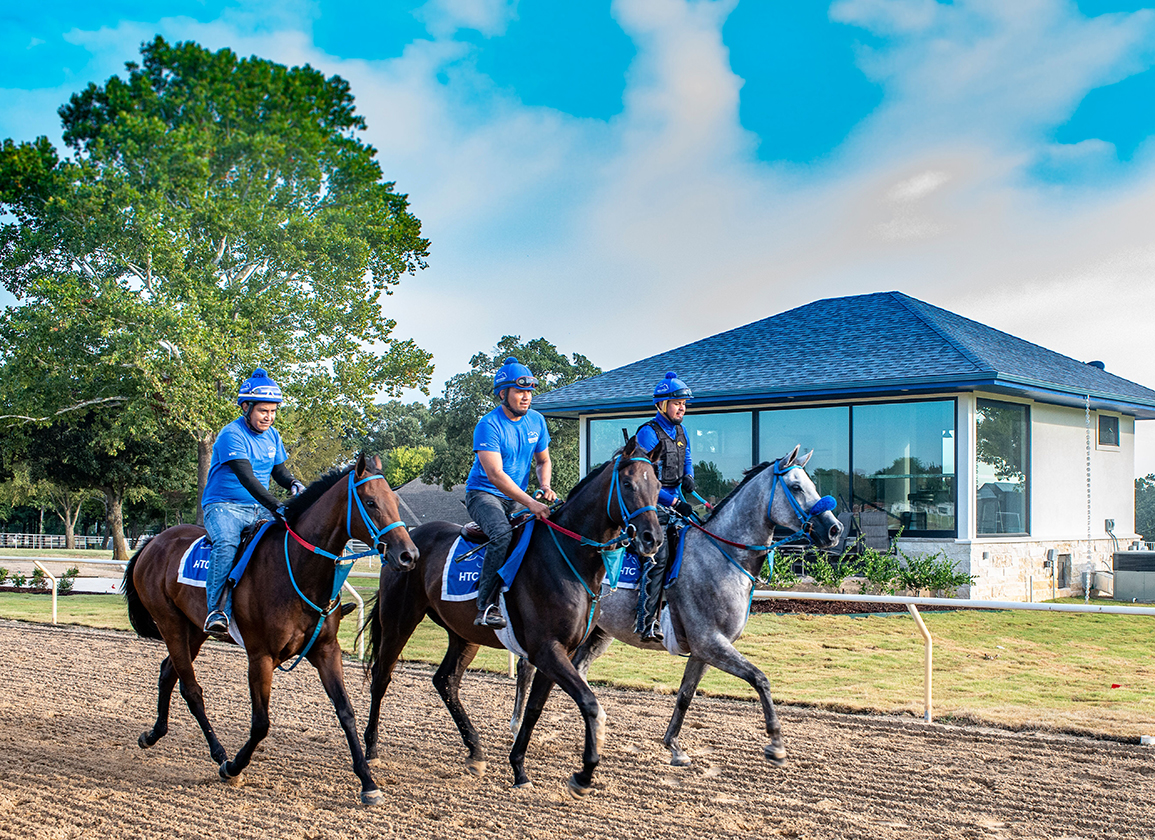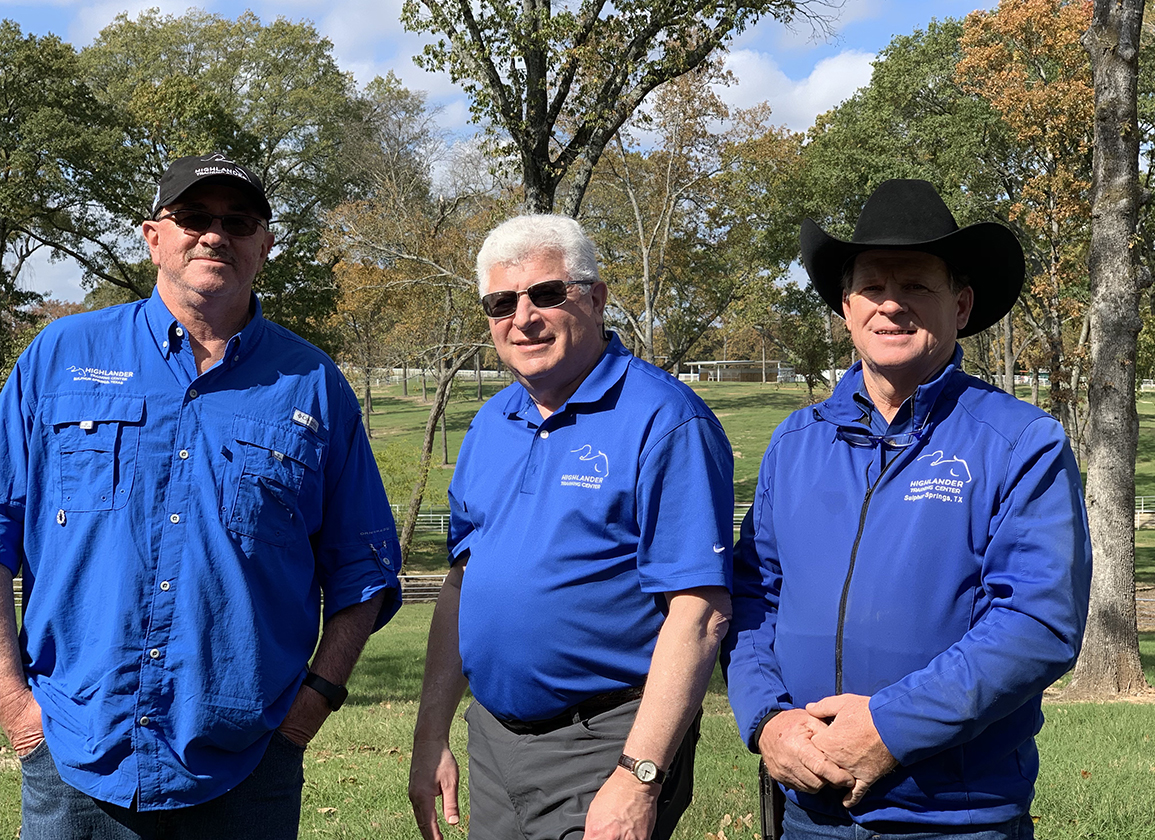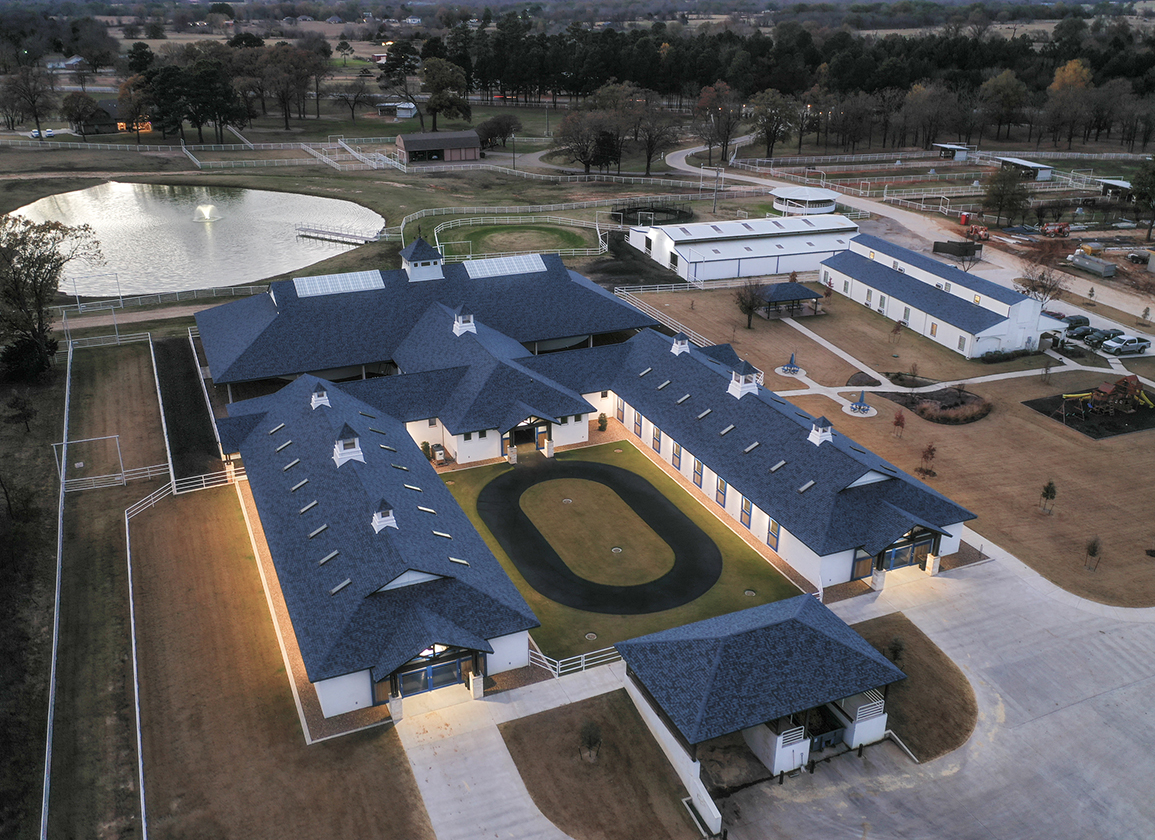SULPHUR SPRINGS, Texas — The head trainer is the guy who prepared 2009 Horse of the Year Rachel Alexandra to be a racehorse. He and his two assistant trainers combine for more than 100 years of experience and the development of more than 300 stakes horses.
Yearlings and weanlings romp in undulating pastures. Two-year-olds learning the fundamentals and older horses coming off layoffs gallop and work over a traditional training track as well as lope up a 1 3/8-mile turf gallop.
The spacious barns have vaulted ceilings featuring skylights that can open and close via remote control but are programmed to automatically shut when rain starts. The 12′ X 12′ stalls with springy flooring underneath the bedding provide horses maximum comfort. Think of it as box springs for equines.
A therapy center opened a year ago in the facility owner's quest to make long racing careers the norm and to keep small problems from becoming big problems. Depending on horses' needs, they could head to the above-ground cold saltwater spa where 35 degree water churns around their legs, in-ground and above-ground aqua treadmills or two stalls with full vibration-plate floors. They might be treated with a regenerative laser or wear an electro-magnetic blanket. Or any combination of the above.
“You'd think you just drove into Lexington, not Sulphur Springs, Texas,” said trainer Lon Wiggins. “It's a hidden gem right now, but it's not going to be for long.”
No, it's not Central Kentucky; rather, Highlander Training Center an hour east of Dallas. Sulphur Springs, population 16,000, is home to the Southwest Dairy Museum and Education Center, which chronicles the town's roots as Texas's one-time dairy capital. The region is populated with cattle farms interspersed with horses of various breeds.
“I know of only one other facility similar to this, which would be WinStar,” said Dr. Ali Broyles, the veterinarian and equine surgeon who oversees Highlander's equine medical care.
“For this kind of weanling-throughout-racing timeline, in addition to these therapy modalities, there are not very many facilities of this scope in the country,” said Broyles, whose post-vet school training was at Lexington's world-famous Rood and Riddle Equine Hospital. “It's a relatively new facility, but I know they have already seen a lot of growth and acceptance from the Thoroughbred community on a national level.”
 For years, horse owner Larry Hirsch trusted his yearlings, 2-year-olds and layups to the father-son team of Ed and Scooter Dodwell at their Diamond D Ranch in Lone Oak, Texas. After Ed died and the ranch was put up for sale, Hirsch opted to establish his own training center rather than relocating to an existing facility. He told Scooter Dodwell, who headed Diamond D for 13 years after his dad's retirement, to “find us” a property.
For years, horse owner Larry Hirsch trusted his yearlings, 2-year-olds and layups to the father-son team of Ed and Scooter Dodwell at their Diamond D Ranch in Lone Oak, Texas. After Ed died and the ranch was put up for sale, Hirsch opted to establish his own training center rather than relocating to an existing facility. He told Scooter Dodwell, who headed Diamond D for 13 years after his dad's retirement, to “find us” a property.
After looking statewide, Dodwell, now Highlander's president in addition to head trainer, found the ideal property a mere 12 miles away from the location of the Diamond D. But it was hardly turn-key. The old Rafter L Ranch had been vacant for years, its main barn in disrepair, the training track overgrown. Trees had taken over the fields.
“But you could see it had 'good bones,'” Hirsch said of the land. “It's beautiful property, great topography–as opposed to flat ground in Texas. It had rolling grounds that came down, which means that water and rain–which we have a lot of in east Texas– would roll off the property. It was treed, which meant we have shade for our horses. It had a wonderful track that hadn't been used for 20 or 25 years. But the soils, everybody we showed them to said they're extraordinarily good for preserving the health and training of horses. It wasn't hard to come to the conclusion that this was the right place to be.”
Since he couldn't have his horses at Diamond D, Hirsch brought the ranch to the new venue, with much of the Diamond D crew relocating with Dodwell. That included Jon Newbold, the assistant trainer and general manager tasked with getting the Sulphur Springs land to where building could begin and be ready for horses to return.
Newbold estimates that he and his crew cleared out 300 trees. He personally trimmed up those remaining. Almost all of the fencing was replaced and an area where broken and rusty machinery had been stashed was cleared and cleaned up. The existing barn went through an extensive makeover and new barns were constructed.
“The front pasture by the main road, we took out 70 trees to make it usable. I mean, it was wilderness,” Newbold said. “It was really beautiful, but it was a challenge to get it fenced to where we could make it functional. To see all of the progress and the transformation, there has been so much done every single day to get it to where it is now.”
Trainer Bret Calhoun–whose main divisions are in Kentucky, Louisiana and Texas and whose clients include Hirsch–calls Highlander “just a great facility anywhere it would be in the country. But for the Midwest and South, the facility is badly needed: a complete facility, a breaking and training operation with a great rehab facility as well. They have spared no expenses and made it top notch.”
Hirsch named Highlander Training Center after his Dallas-based global private equity firm Highlander Partners.
 It is clear that Hirsch has used the same principles that have worked so well with his firm at the training center. Highlander Partners invests only their own money, are big on flexibility and loathe to bureaucracy. Strategies emphasize having no limits, restrictions or artificial deadlines while playing the long game and investing in a broad range of industries and entrepreneurial endeavors. While an involved boss, Hirsch's management style is to get the right people in the right spots and let them do their job, giving them the tools they need for success.
It is clear that Hirsch has used the same principles that have worked so well with his firm at the training center. Highlander Partners invests only their own money, are big on flexibility and loathe to bureaucracy. Strategies emphasize having no limits, restrictions or artificial deadlines while playing the long game and investing in a broad range of industries and entrepreneurial endeavors. While an involved boss, Hirsch's management style is to get the right people in the right spots and let them do their job, giving them the tools they need for success.
When he bought the property in 2017, Texas racing and breeding industries had been pummeled, the heady days when Lone Star Park hosted the 2004 Breeders' Cup long gone. The reality was bleak.
Texas tracks could not compete with the slots-enriched purses offered in neighboring Louisiana, Oklahoma and Arkansas. Texas purses in 2017 totaled $14.5 million–less than half the $32 million paid out to horse owners 15 years earlier. The foal crop of Texas-born horses plunged from more than 2,000 to 407 five years ago and was destined to shrink more.
Gee, what better time to invest in a training center?
But Hirsch saw the investment as sending a powerful message to the Texas legislature and the state's elected leadership. Highlander Training Center showed the promise of Texas racing, which produced legendary horses such as Triple Crown winner Assault, Kentucky Derby and Belmont winner Middleground and champion Stymie–all while pari-mutuel horse racing was banned in the state.
“We definitely had a vision for creating something special for the state of Texas,” Hirsch said last month. “While we didn't know for sure the legislation would be passed to help our industry, we knew that the industry, the people, the owners, the trainers, etc., would come back to Texas if we could create something unique, at least for our area of the country. That was the vision, the thesis behind the training center. I think if you look at it today, it's been fully realized, and we're not done yet.”
In 2019, Texas passed legislation directing half of the funds from the sales tax on horse feed, tack and other equine products into the money horsemen race for at the state's tracks. The returns were almost immediate, with dramatically enhanced purses totaling $26.5 million last year, a resurgence at the Texas Thoroughbred auctions and an atmosphere of optimism.
However, Hirsch doesn't see Highlander as serving only Texas and the Southwest.
“We think the quality of care, the quality of what we're doing, the therapy center we've created, the commitment to excellence is attracting owners already from Kentucky, from Minnesota, Louisiana,” he said. “So it is a national operation in Texas, as opposed to a Texas-only operation.”
Hirsch brought aboard Highlander CEO Jeff Hooper in 2019. Hooper is one of Texas's most respected executives, having worked on both the racetrack (Lone Star Park) and horsemen's (Texas Thoroughbred Association) side. Jose “Cuco” Mendez, assistant trainer and co-general manager, was hired to work alongside Dodwell and Newbold after 28 years working as an exercise rider, assistant and trainer. Office manager Dee O'Brien, from a horse-racing family and with extensive experience on the equine auction side, heads up administrative functions, including client relations and new project initiatives.
“We think horsemanship is the key and foundation of what we do here,” Hooper said. “We want to bring each horse to the best of their abilities, whatever that may be. We're fortunate to have experienced and highly professional people in all of our leadership roles here. But we always want to learn from others, too, and blend old-school horsemanship with the cutting edge technologies available. Racing can be a game of inches. So, anything we can do to help these horses achieve what they're capable of, we want to have those tools at our disposal.”
That included last year's opening of 11,000-square foot Highlander Fitness and Therapy Center, the on-sight operation overseen by former jockey, trainer and highly respected horsewoman Shannon Ritter, who held a similar position at WinStar Farm. Soft-tissue injuries that once would have forced a horse's retirement are treated with such tools as the ground-breaking RLT Vet Regenerative Laser Therapy. Diagnostic equipment on hand include a portable digital X-ray machine, ultrasound and dynamic endoscopy (examining the upper airway to detect abnormalities that may only be found during high-speed exercise).
“Everything is state of the art,” Ritter said. “It's a facility that could be in Lexington, with everything it has. But Larry Hirsch has built it here, a beautiful facility in Texas.”
The therapy center was a critical part of Hirsch's game plan.
“What is going to make you different from competition from Ocala, Kentucky, Louisiana etc.?” Hirsch said. “Those of us who believe we want to have horses that run at four and five years old, and retain them in a healthy manner throughout their lives, know the importance of having some place to lay up horses, some place to improve them, some place to get over injuries. That was the concept: Differentiation with quality, with creating something special here.
“High-level owners, premium owners, people who are creating the stakes-winners of the future know quality. They've bought quality, and they want quality to prepare, train and care for them.”
The Highlander crew, which includes six full-time riders and 14 full-time grooms, works as a team on all facets of training, handling yearlings, 2-year-olds and older horses alike. An integral part of the Highlander philosophy is to keep young horses outside as much as possible to romp and play.
“We raise them outside, so they build more bone,” Dodwell said. “We feel we can raise good, sound, horses here with high-quality feed, hay and management, while still letting the horses be horses.”
Many of Dodwell's Diamond D clients are also strong believers in this approach, and have followed him to Highlander.
“They do an outstanding job with the horses,” said owner Fred Walden. “The horses get everything they need. If I do it myself, I might say, 'Well, I'm going to skimp on worming' or something, or I might not get the farrier at home to trim them when I should. But at Highlander they don't miss a beat.
“After the babies come off the mares at six months, I just leave them right there (at Highlander) and let them grow up with their buddies. I was down there the other day, was going to pick up a colt–thought I'd save some money. My yearling was out there with his buddies, running around and they're just building themselves up, growing into maturity and doing really well. I said, 'Well, I might save some money if I take him home, but I might have to pay more in the long run if he's not out there with his buddies growing up like he is now.'
“Now you've got a place where you can take them when they're six months old and let them grow up and Highlander take care of them and put them on the track,” Walden said. “You can go and enjoy them at the track, or you can visit them any time at Highlander. I have two broodmares and 15 acres. I rely on them really heavy at Highlander to take care of what I do and don't know.”
The post Highlander a World-Class Facility in East Texas appeared first on TDN | Thoroughbred Daily News | Horse Racing News, Results and Video | Thoroughbred Breeding and Auctions.

